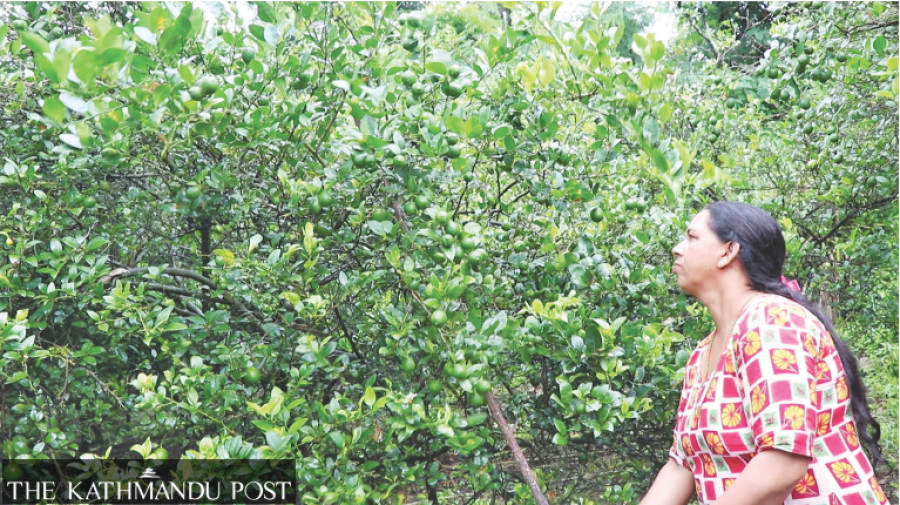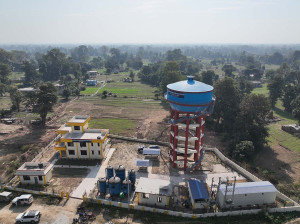Money
Palpa emerging as lime growing district
Farmers are giving up traditional cereal crops and turning to growing fruits because it is more lucrative.
Madhav Aryal
Long known for colourful handloomed Dhaka textiles, Palpa district in central Nepal is now making a name for itself as a producer of lime. Commercial agriculture is spreading in the region as more farmers are giving up traditional cereal crops and turning to growing fruits because it is more lucrative.
Goma Bhandari from Masyam village in Palpa decided to switch to lime cultivation three years ago, as the grains she had been growing yielded low returns.
Her decision paid off. She earned Rs1.4 million in a year by selling the citrus fruit. The fields where Bhandari used to grow maize, mustard and wheat are now covered with lime trees. Bhandari has 400 lime trees in her orchard, and she also sells lime saplings.
The small sour fruit is in high demand in Nepal and prices are rising. A medium-sized lime costs between Rs15 and Rs20 per unit.
The spike in lime prices has been primarily attributed to a shortage in supply in India, and high demand during the ongoing summer season. In Nepal too, a scarcity has pushed up prices, according to traders.
“I started growing lime by bringing saplings from the eastern hill district of Dhankuta around nine years ago,” said Bhandari.
The trees start producing fruits after three years. Farmers in Palpa have been attracted to lime due to the surge in demand in recent years.
"Besides proper management of the orchard, protecting the fruits from pests, sufficient fertiliser and irrigation facilities are vital for a good harvest," said Bhandari. “We expect the yield to increase in the coming years.”
As the family's income from lime has quadrupled, Bhandari’s husband, Humnath, decided to quit his teaching job which he had held for 22 years.
He is now devoting his full time to looking after their orchard. “Growing lime has been very satisfying,” he said.
Though limes can be grown in the Tarai as well as the hills, only a few people are involved in commercial production, according to Milan Gaire, a technician at the Agriculture Knowledge Centre, Palpa.
“Production was low in the past years as farmers only cultivated cereal crops,” said Gaire. “However, the number of farmers abandoning cereal crops has increased.”
This is because all three tiers of governments—federal, provincial and local—started providing saplings at subsidised prices.
In Palpa, the government bears 50 percent of the cost of a lime sapling, said Gaire.
Farmers have planted more than 15,000 saplings at Masyam alone in the past few years. The knowledge centre also runs a programme to promote lime farming.
A farmers’ group consisting of 10 to 20 farmers is formed for commercial production of the citrus fruit. They grow limes collectively.
"More than 10,000 saplings have been provided to farmers through this programme in the last fiscal year," said Gaire.
The Prime Minister Agriculture Modernisation Project too has been providing lime saplings at subsidised rates.
"The government's lime mission programme has been motivating farmers," said Deepak Bhattarai, senior agriculture development officer of the project.
Rainadevi Chhahara, Bagnaskali, Tinau and Rambha rural municipalities and Tansen and Rampur municipalities distributed more than 15,000 lime saplings to farmers in the last fiscal year.
“We provided lime saplings to some poor farmers free of cost,” said Rukmangat Bhattarai, chairman of Rainadevi Chhahara Rural Municipality.
The efforts of the government have motivated the farmers, according to farmer Santosh Bashyal of Tansen Municipality-1 who has planted 200 saplings in the past four months.
“The saplings are growing well,” said Bashyal.
While some government institutions have provided grants for the transportation of the saplings, foreign donors such as United Nation Development Programme (UNDP) and Heifer Project Nepal, among others, have provided saplings to farmers as grant.
The federal and provincial governments started providing lime saplings at half price in the last fiscal year. The government has declared 10 districts including Kabhre, Bhojpur and Dadeldhura as pocket areas for lime farming.
“Around 28 local units across the country have distributed more than 100,000 lime saplings to farmers,” said Januka Pandit, deputy director general at the Department of Agriculture. “The local and provincial governments have also provided saplings at subsidised prices.”
Despite the huge potential for growing lime, Nepal has been importing citrus fruits worth millions every year.
Nepal imported limes worth Rs800 million in the last fiscal year ended mid-July, according to the Department of Customs. Imports in the previous fiscal year totalled Rs910 million.
“If the government gives priority to lime production, imports can be reduced in the coming days,” said Pandit. “There is huge scope for exporting the fruit too.”
In the last fiscal year, the government distributed around 1,600 saplings in Tansen, 760 in Bagnaskali, 400 each in Chhahara and Rampur, and 200 in Nisdi,” said Kamana Adhikari, chief of the Agriculture Knowledge Centre in Palpa.
“We have to increase domestic production to reduce imports. The living standards of farmers can be improved through lime farming,” said Adhikari. “To increase production of the popular fruit, more farmers should be encouraged to go into commercial production.”




 19.12°C Kathmandu
19.12°C Kathmandu















